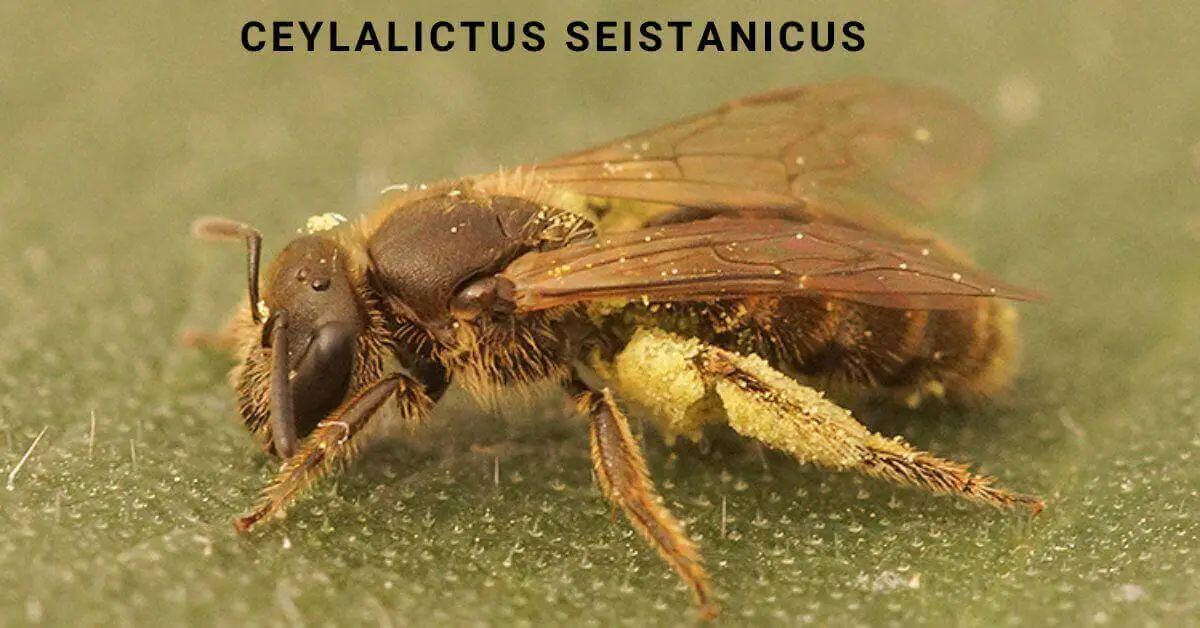Taxonomy: The taxonomy of Ceylalictus seistanicus places it in the order Hymenoptera, which includes bees, wasps, and ants. Within the order, Ceylalictus belongs to the family Halictidae, commonly known as sweat bees. The genus Ceylalictus is a group of small to medium-sized bees found primarily in Asia.
Classification: The species name seistanicus refers to the region where this bee was first discovered – Sistan, a province in southeastern Iran. The scientific name Ceylalictus combines the terms Ceylon, which refers to the historical name of Sri Lanka, and Lictus, derived from the Latin word for “licking” or “gathering.” This name reflects the bee’s behavior of collecting nectar and pollen from flowers.
| Genus | Ceylalictus |
| Species | seistanicus |
| Order | Hymenoptera |
| Family | Halictidae |
Habitat and Distribution of Ceylalictus Bee
Habitat: Ceylalictus seistanicus primarily inhabits arid and semi-arid regions. It prefers dry, open landscapes with sparse vegetation and sandy soils. This species can be found in various habitats, including deserts, grasslands, and scrublands.
Distribution: Ceylalictus seistanicus is native to the Middle East, specifically Iran, Afghanistan, and Pakistan. Its distribution extends into parts of Central Asia, including Turkmenistan and Uzbekistan. This bee has also been reported in some regions of India. The specific environmental conditions of these areas contribute to the bee’s adaptation and survival.
Morphology and Behavior
Morphology: Ceylalictus seistanicus is a small bee with a body length ranging from 6 to 8 millimeters. It has a slender and elongated body shape, which aids in its ability to navigate through narrow spaces within flowers. The bee’s exoskeleton is covered in dense hairs, providing protection and aiding in pollen collection.
Behavior: Ceylalictus seistanicus is a solitary bee species, meaning it does not form large colonies like honeybees. These bees are active during the day and exhibit a remarkable foraging behavior. They are known for their agility and speed while visiting flowers for nectar and pollen collection. Ceylalictus Bees plays a crucial role in pollination, ensuring the reproduction and survival of various plant species.
Importance of Ceylalictus in Pollination
Pollination by Ceylalictus Bee: As a pollinator, Ceylalictus seistanicus plays a significant role in maintaining the biodiversity and balance of ecosystems in its native regions. This bee species has evolved specific morphological characteristics, such as hairy bodies and specialized mouthparts, which allow them to collect and carry pollen efficiently. While foraging for nectar, Seistanicus bee inadvertently transfers pollen from one flower to another, aiding in cross-pollination.
Impact on Plant Species: The pollination services provided by Ceylalictus seistanicus are essential for the reproductive success of many plant species. The bee, Ceylalictus seistanicus, aids in pollination, enhancing genetic diversity and survival of flowering plants, benefiting the ecosystem.
Related Articles:
- Andrena abbreviata Dour: Secrets of an Alluring Bee
- How Do Bees Mate?Reproduction of Honey Bees.
- Bees and Flowers Symbiotic relationship.
Relationship with Humans
Human Interaction: While Ceylalictus seistanicus primarily interacts with the natural environment, there are indirect ways in which humans can affect this bee species. The alteration of habitats through human activities such as agriculture, urbanization, and land-use changes can impact the availability of suitable foraging resources for Ceylalictus seistanicus and other pollinators.
Conservation Efforts: Recognizing the ecological importance of Ceylalictus seistanicus and other pollinators, conservation efforts are underway to protect and promote their habitats. Initiatives such as creating pollinator-friendly landscapes, preserving natural habitats, and promoting sustainable agricultural practices can contribute to the conservation of Ceylalictus bee and the overall well-being of pollinator populations.
Awareness and Education: Raising awareness about the significance of pollinators like Ceylalictus seistanicus is crucial in fostering a sense of responsibility and encouraging actions that support their conservation. Education programs, outreach initiatives, and public campaigns can help people understand the role of pollinators and the need to protect their habitats.
Research and Scientific Studies of Ceylalictus seistanicus
Scientific Interest: Several studies have focused on understanding the bee’s behavior, foraging patterns, habitat requirements, and its contribution to pollination networks. These studies aim to gather valuable insights into the ecology of Ceylalictus seistanicus and its interactions within its natural environment.
Summary
Ceylalictus seistanicus is a fascinating bee species with unique characteristics and a crucial role in pollination. Understanding its taxonomy, habitat, behavior, and ecological significance provides valuable insights into the delicate balance of our natural ecosystems.




